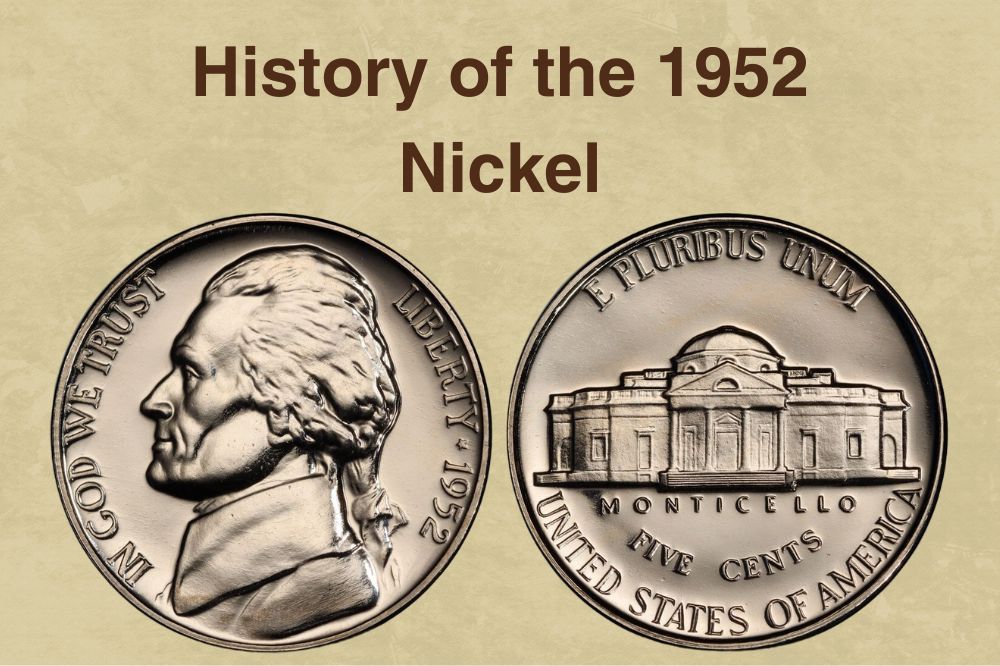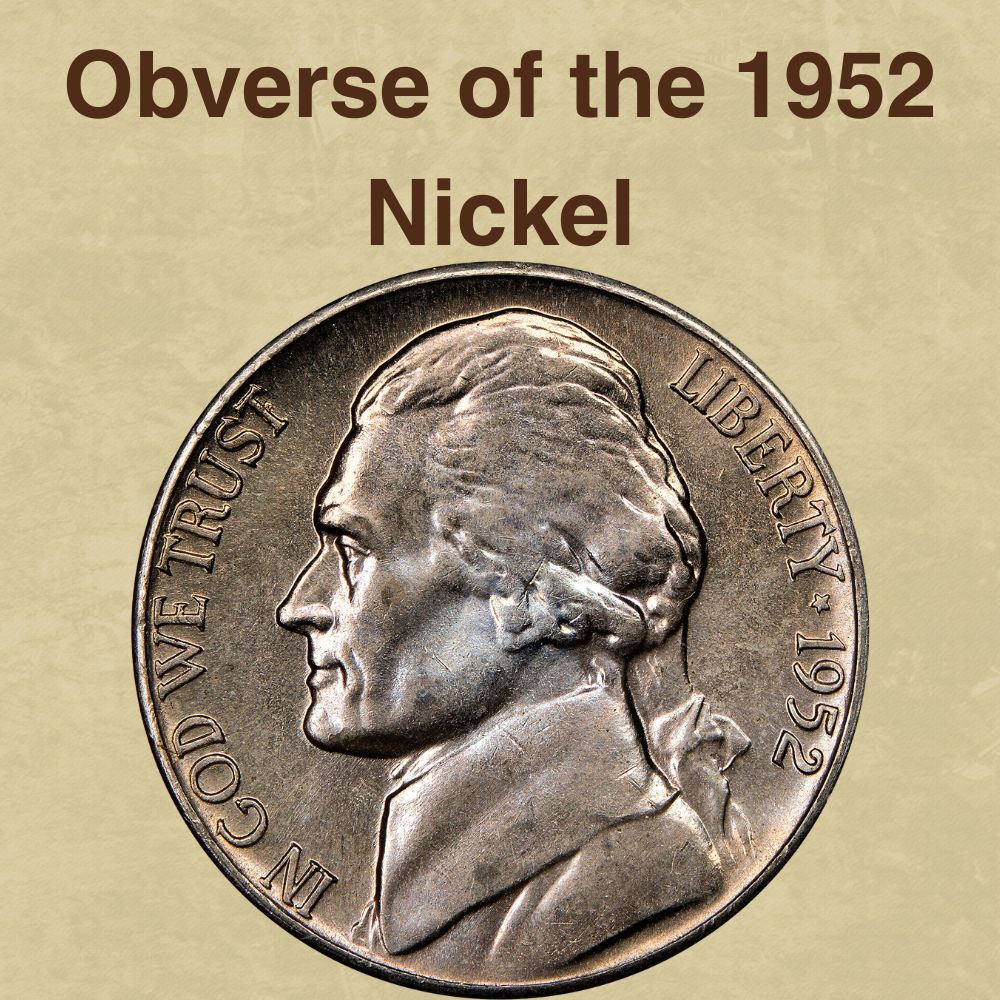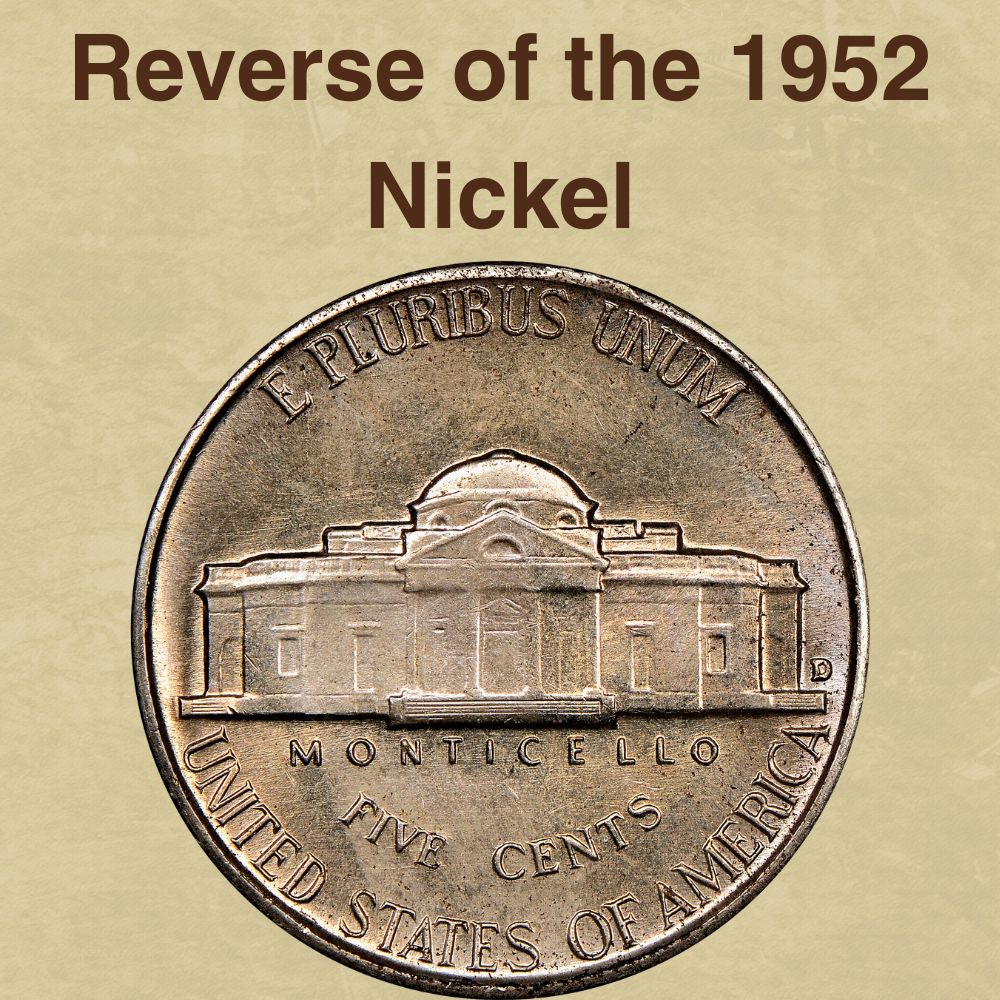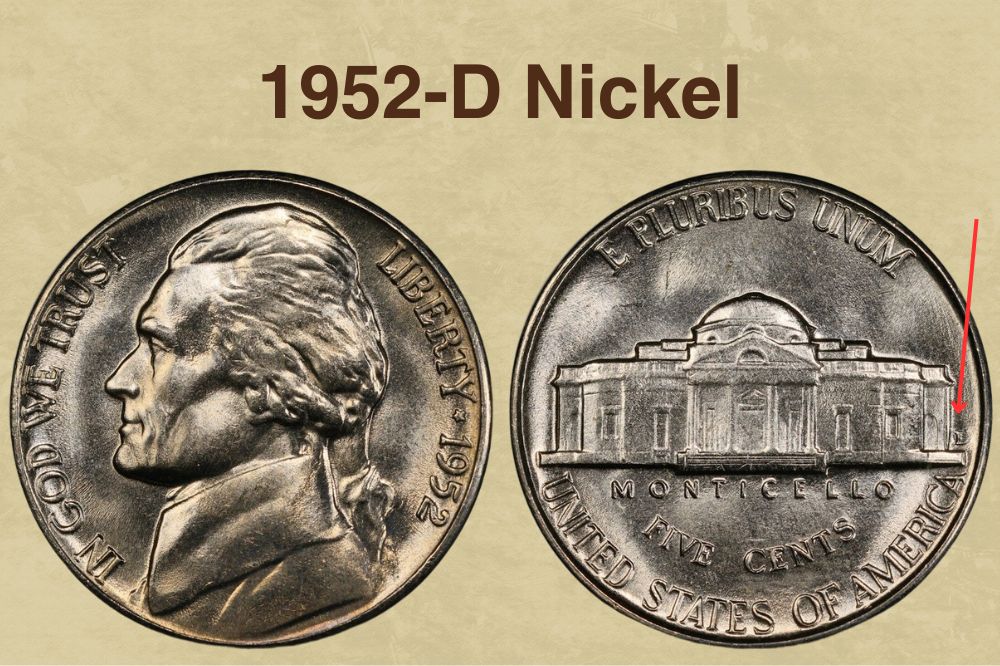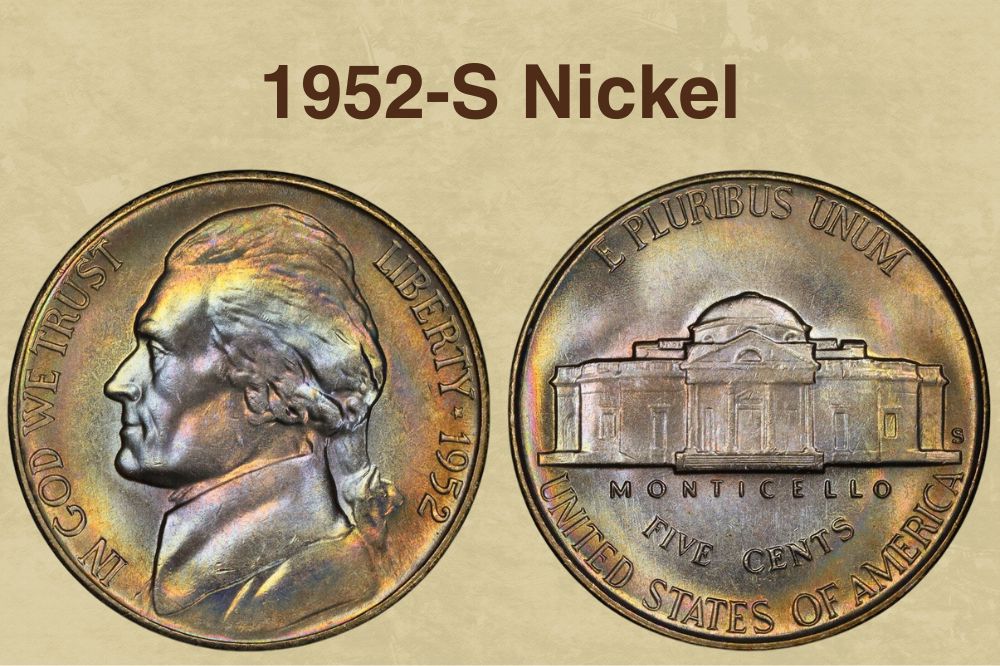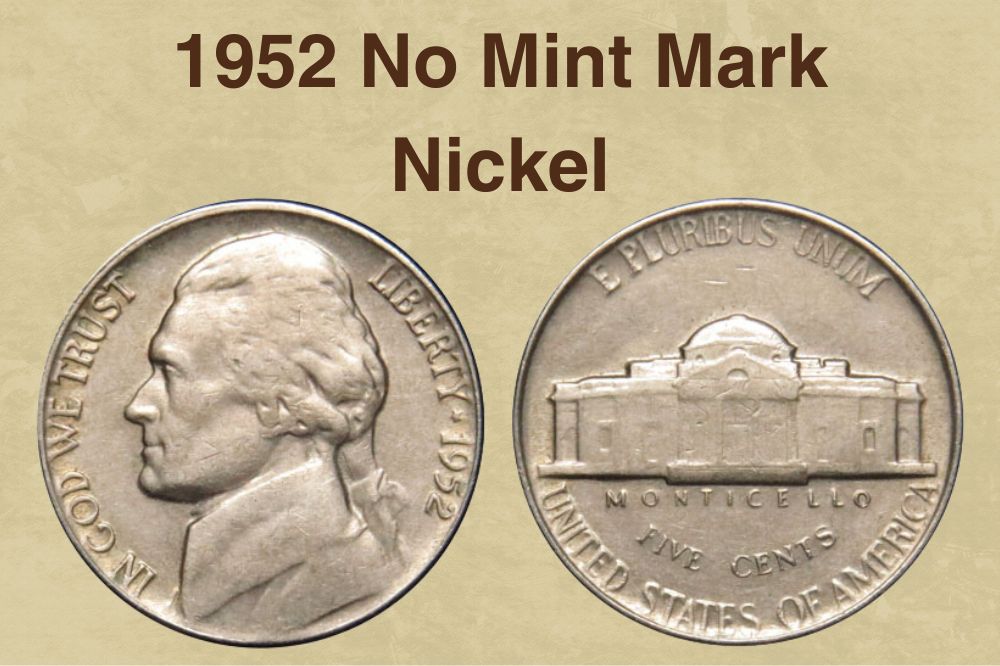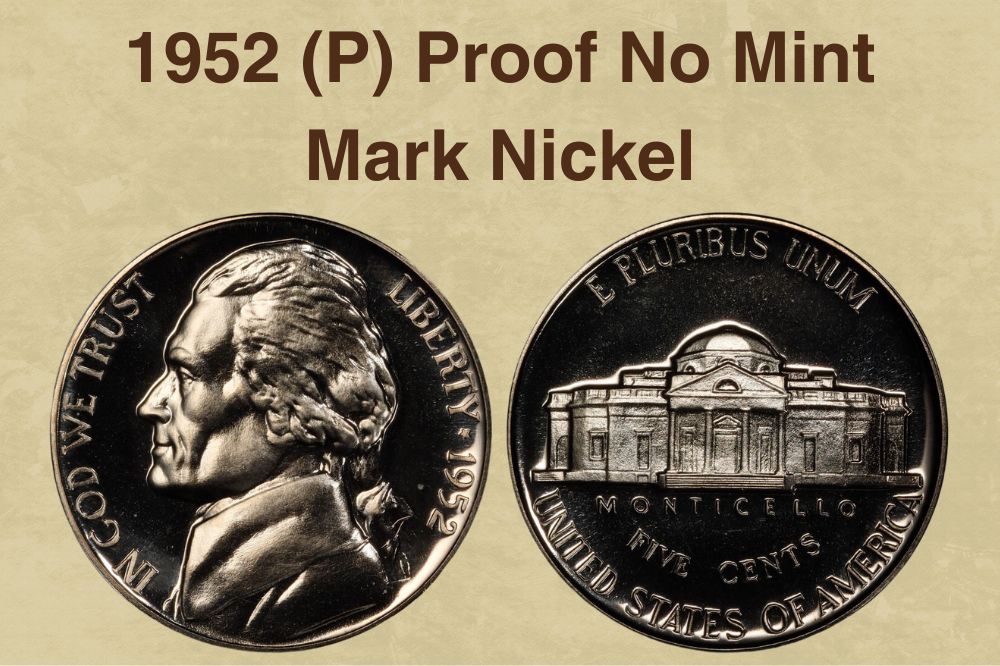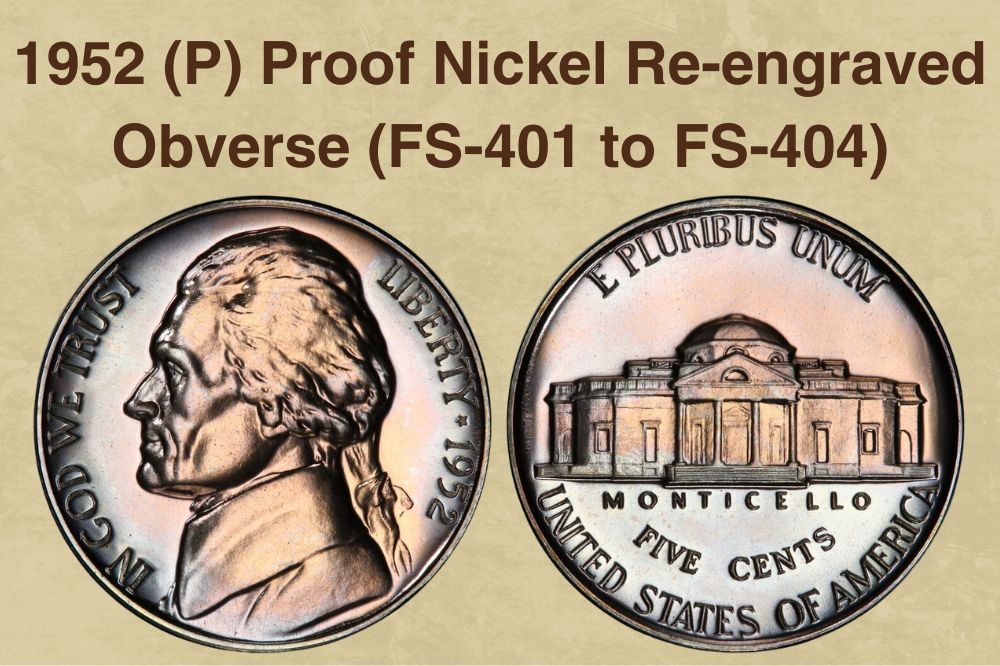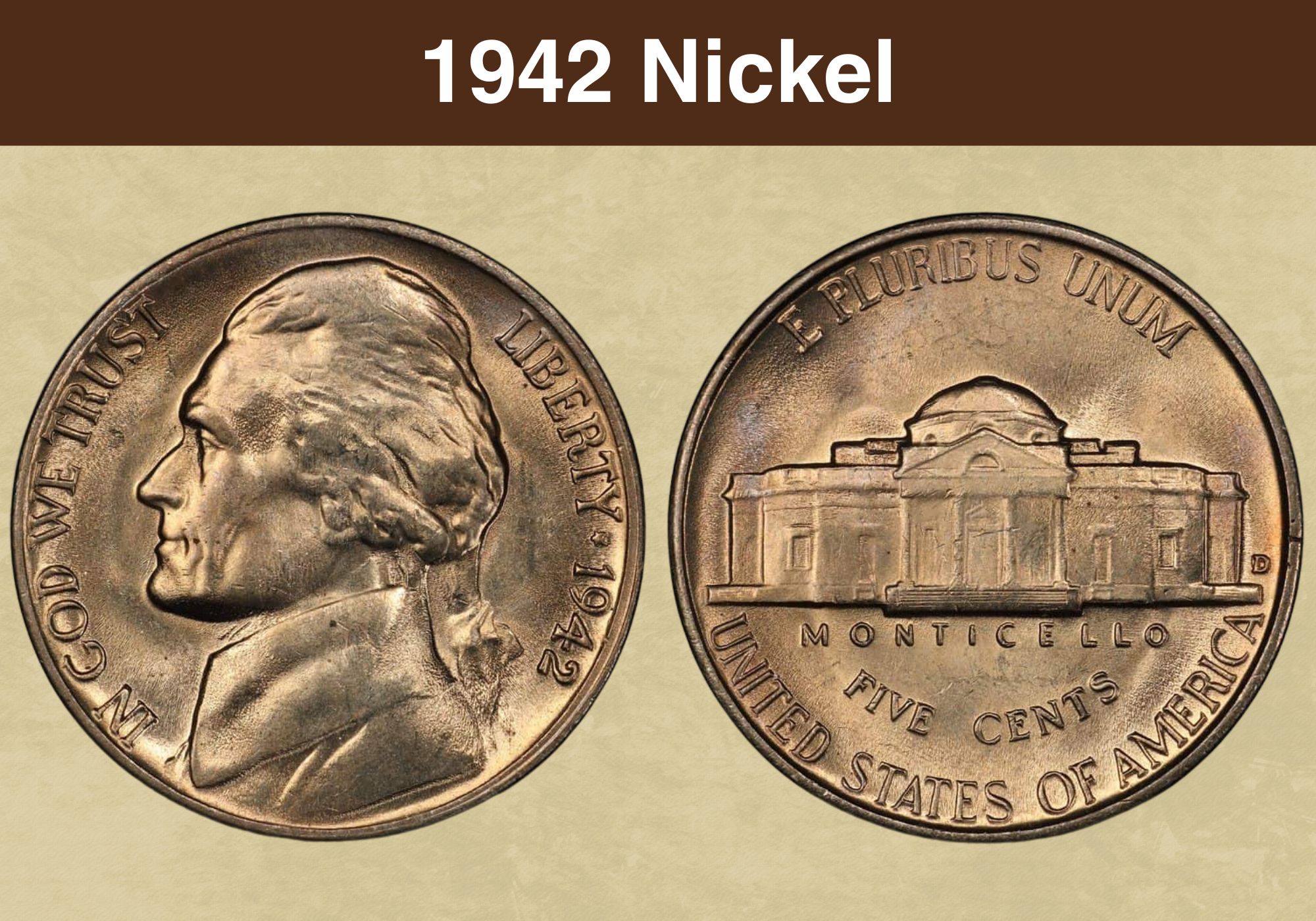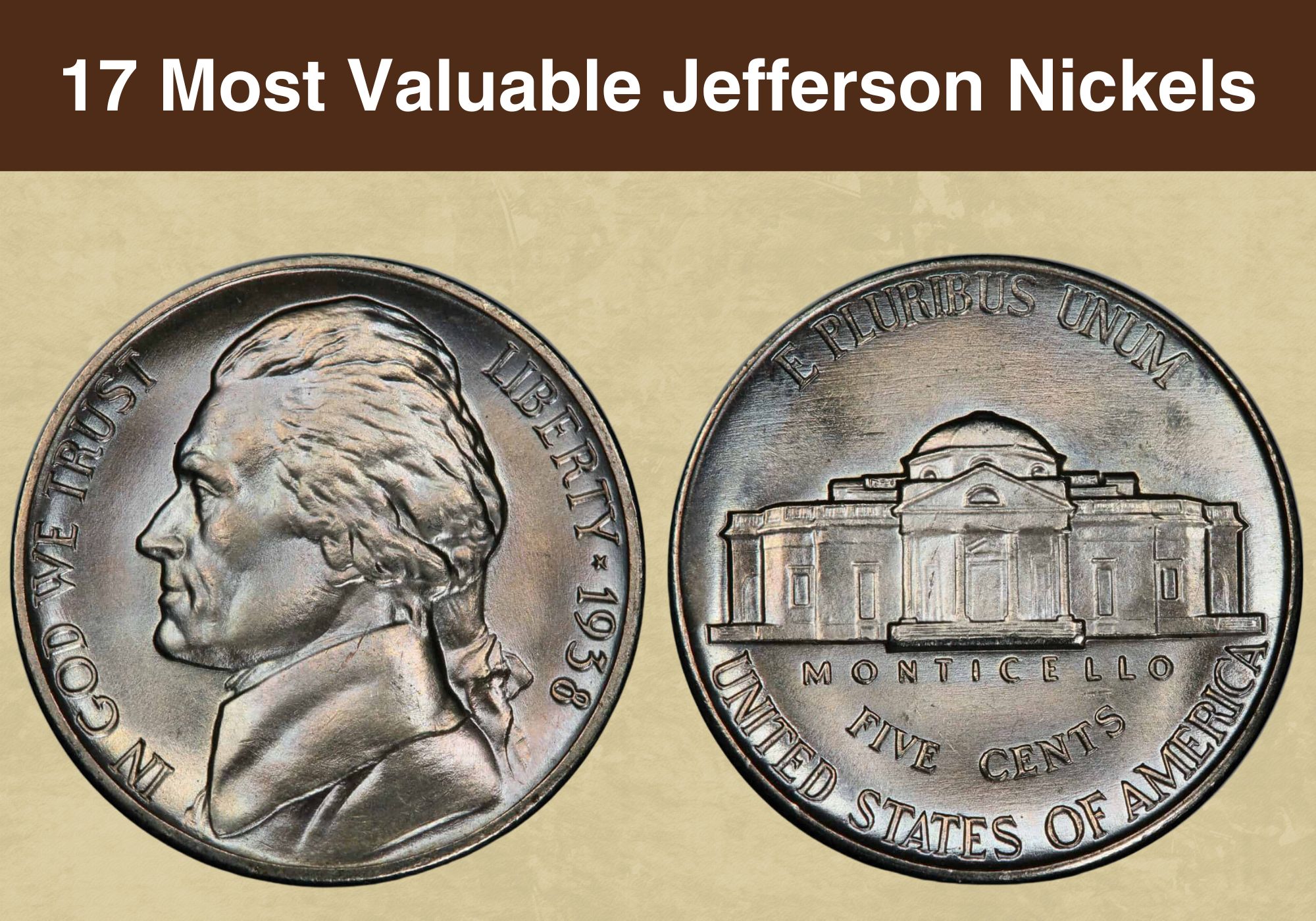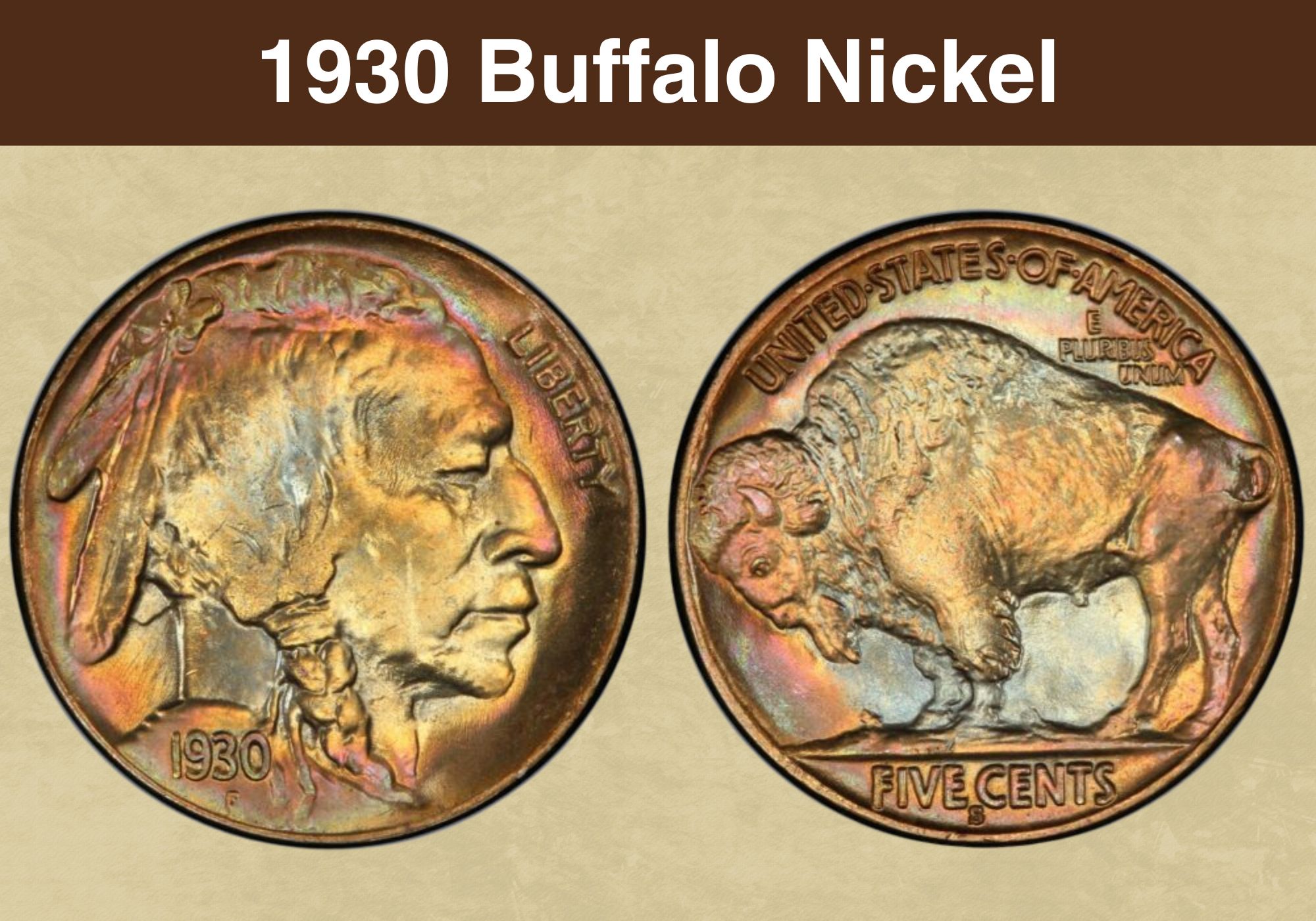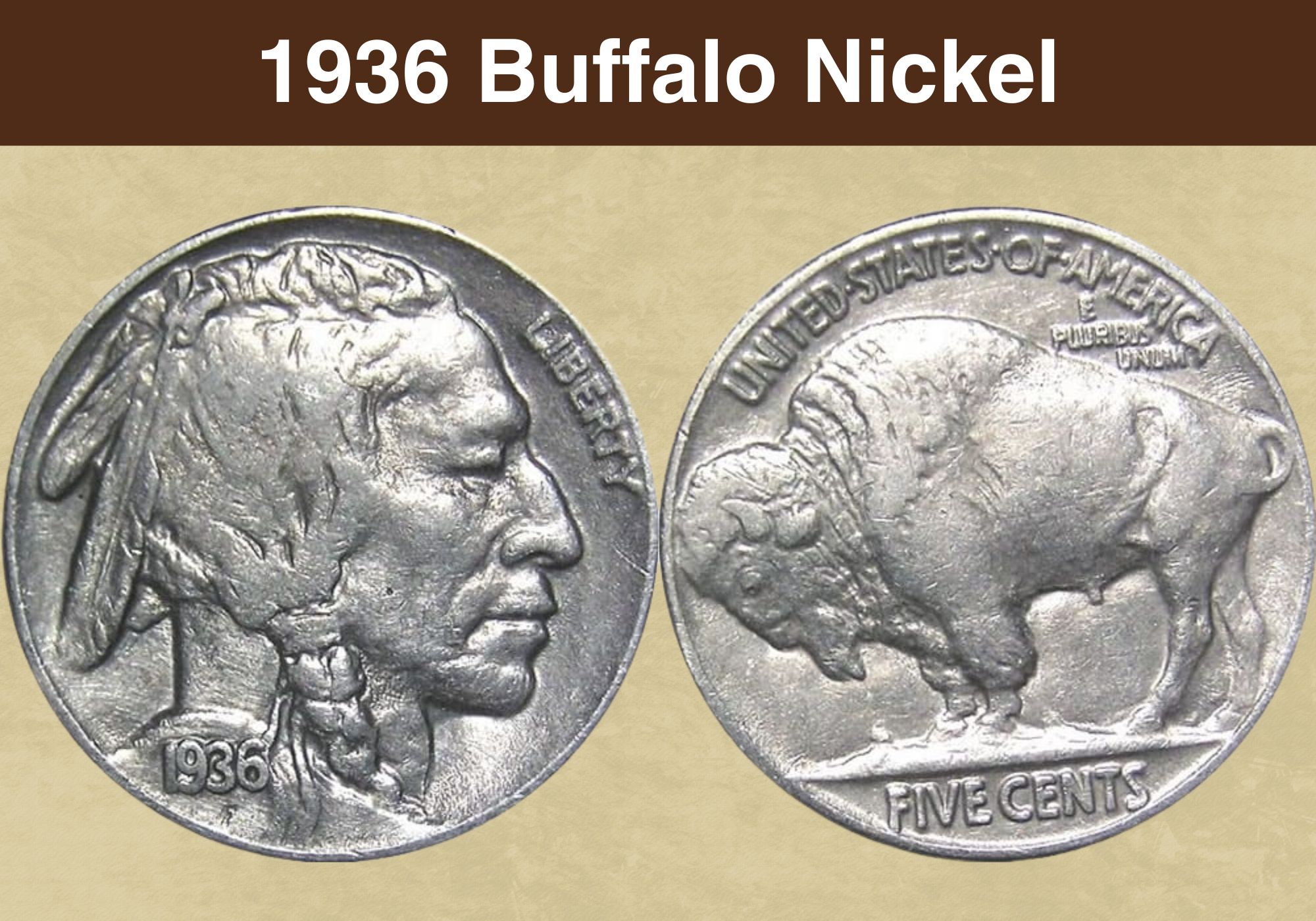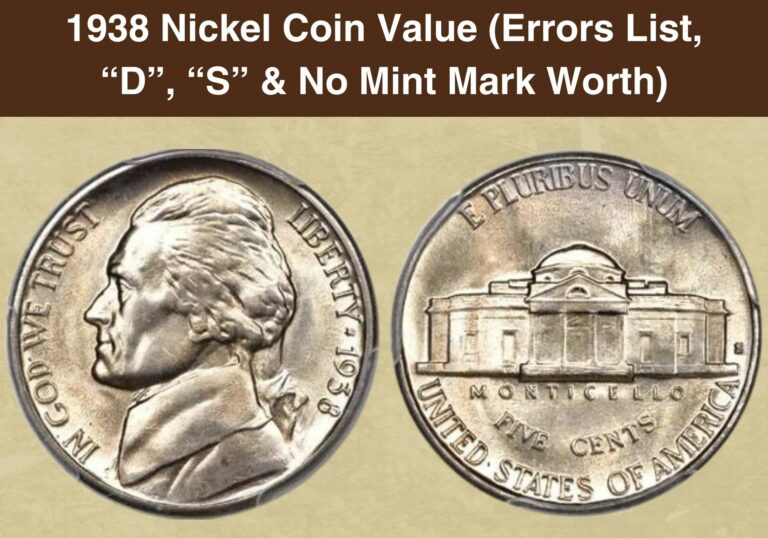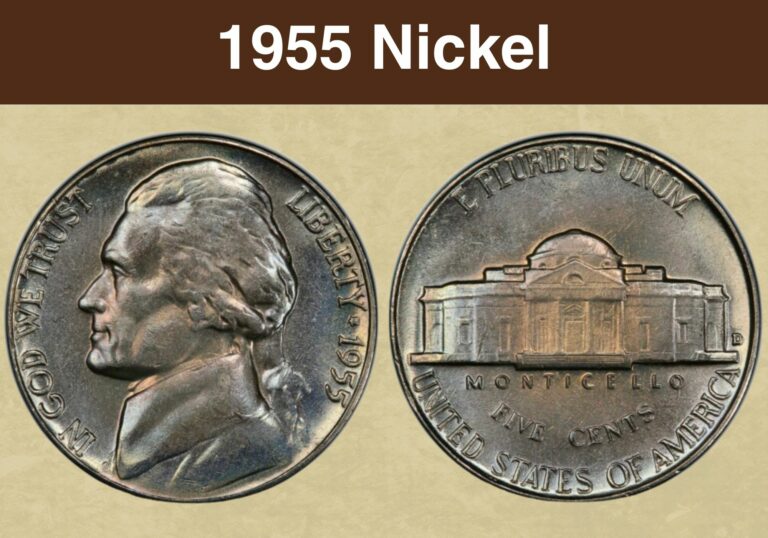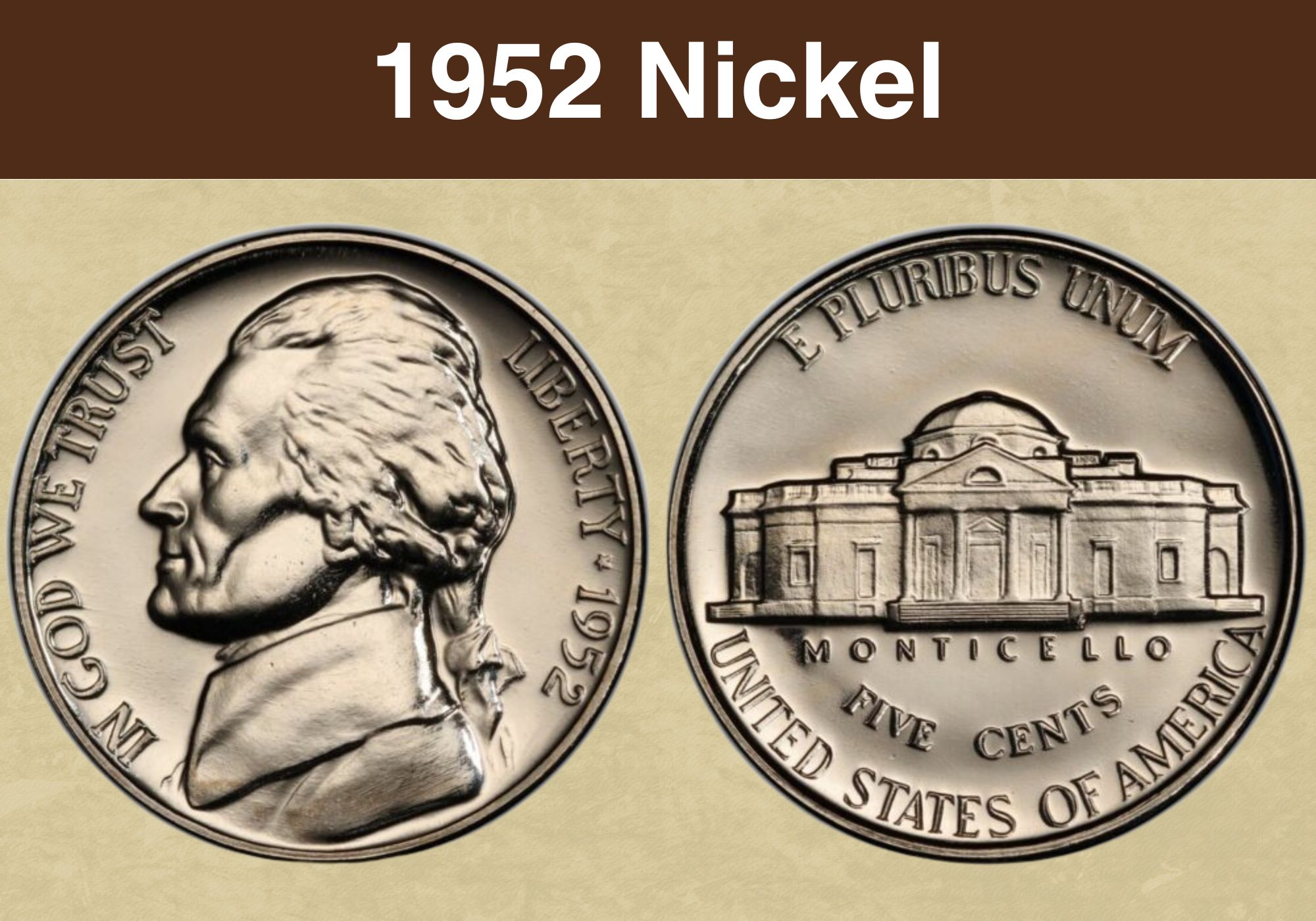
Coin Value Contents Table
- 1952 Nickel Value Chart
- History of the 1952 Nickel
- Features of the 1952 Nickel
- 1952 Nickel Grading Guides
- 1952 Nickel Value Guides
- 1952-D Nickel Value
- 1952-S Nickel Value
- 1952 No Mint Mark Nickel Value
- 1952 (P) Proof No Mint Mark Nickel Value
- Rare 1952 Nickel Errors List
- Where to Sell Your 1952 Nickel ?
- 1952 Nickel FAQ
The Nickel is a 5c American coin. And even though it has more copper than nickel, the shiny silver color gave the coin its nickname. This is important because 5c coins were originally made of silver. So when the precious metal got too expensive, the US Mint needed to ensure the coins still looked luxe and silvery. Let’s assess the 1952 Nickel Value and learn its history.
1952 Nickel Value Chart |
||||||
| Coin | MS 63+ | MS 64+ | MS 65+ | MS 66+ | MS 67 | PR/PF 69 DCAM |
| 1952-D Nickel | $11 | $17 | $255 | $140 | $4255 | – |
| 1952-D Nickel Full Steps | $65 | $135 | $165 | $850 | $5,850 | |
| 1952-S Nickel | $6 | $18 | $26 | $50 | $700 | – |
| 1952-S Nickel Full Steps | $72 | $175 | $375 | $1,250 | $11,000 | – |
| 1952 No Mint Mark Nickel | $9 | $18 | $35 | $165 | $1,050 | – |
| 1952 (P) No Mint Mark Nickel Full Steps | $125 | $525 | $1,950 | $8,150 | – | – |
| 1952 (P) No Mint Mark Proof Nickel | – | – | – | – | – | $11,750 |
History of the 1952 Nickel
Before it earned nickel as a nickname, the 5c coin was known as a Half Dime (or sometimes as Half Disme, silent ‘s’). And that can be puzzling because physically speaking, nickels are larger than dimes. There’s a perfectly logical reason for this though. In the early days, most coins were made of precious metals i.e. silver and gold. These were known as specie metals.
But over time – and for various reasons – US coins converted to base metals like steel, zinc, nickel, and copper. But the Dime (10c coin) kept its silver content longer than the so-called Half Dime. That meant the Dime required a smaller diameter to ensure its face value aka denomination was below its melt value i.e. the market price of silver used in a melted coin.
So even today, when both nickels and dimes are base metal coins, their earlier size hasn’t changed. Also, curiously, the nickel was the first legal tender to experiment with the alloy that eventually coated all US coins. This mix of 75% nickel and 25% copper showed up in 1866 and is still used on 5c coins today. It’s also the outer clad layer of other denominations.
The Politics of Nickel in Early US Coins
Interestingly, the nickel was never intended as a permanent piece. As Mint Director James Pollock explained, it was temporarily introduced to replace the 5c note. Pollock wasn’t a fan of base metal money. But this was a wartime era where precious metals were scarce and people were using regional paper money. These notes weren’t centralised so they were easily forged.
The mint tried a 2c piece that was 95% copper from 1864 to 1873. They also tried a silver 3c piece known as a trime from 1851 to 1873. But the 3c later changed to 75% copper and 25% nickel, providing a case study that eventually led to a 5c piece in the same base metal combo. Pollock felt these coins could step in until the nation moved back to silver and gold currency.
But nickel magnates lobbied for the continued use of nickel coins, and the public had already embraced them. From 1865 to 1889, the nickel 3c piece circulated widely, and when it no longer made financial sense, the 5c nickel – which everyone now called the nickel – became the smallest silver-colored denomination. Only the 95% Copper Penny had a lower value.
The Unusual Design Details of the Jefferson Nickel
Of all the coins that currently circulate in the US, only the Jefferson Nickel has United States of America at the bottom of the tails side. On other coins, the name of the country goes at the top. This design feature traces back to the coin’s beginnings in 1938. At the time, designer Felix Oscar Schlag mis-positioned it. He was asked to change it, but somehow he never did!
Over the years, United States of America swung to the top of the tails side in 2004 and 2005 for the Westward Journey Series. They had four distinct reverse designs (the reverse is the back or tails side of the coin) to commemorate the Bicentennial of the famed Lewis and Clark Expedition. The coins minted in 2005 also had a unique obverse (i.e. the front or heads side).
But in 2006, the original reverse was restored, complete with its bottom-based country. How come? A Virginia Representative named Eric Cantor wanted to be sure Monticello wouldn’t be taken off the coin since it was an important state landmark. So he wrote a bill to guarantee the Monticello reverse would revert after the Bicentennial Nickel redesign of 2004 and 2005.
Also read: Top 10 Most Valuable Nickels Worth Money
Features of the 1952 Nickel
To professionally describe the features of a coin, it helps to know the jargon. We already mentioned obverse and reverse, but the thin side is called the edge and the raised border is the rim or collar. The images on the coin are devices, the words are mottos or legends, and the background is the field. Blank discs called planchets are struck with dies to make coins.
The Obverse of the 1952 Nickel
It shows Thomas Jefferson, the 3rd US President. The motto In God We Trust is on the left, in front of Jefferson. Behind him, it says Liberty, followed by a star and the date. The obverse of the 1952 Nickel differs from other years in several key ways. It doesn’t yet have the designer’s initials, which weren’t added until 1966. Also, the 1952 Nickel has no obverse mint mark.
The Reverse of the 1952 Nickel
It shows Monticello, Jefferson’s famous mansion in Virginia. The word Monticello is under the building, followed by the denomination or face value, Five Cents. Below that is the legend United States of America, curving from one end of the building to the other. The top of the coin has the motto E Pluribus Unum. The mint mark sits on the right side of the building.
Other Features of the 1952 Nickel
As we said before, the 1952 Nickel is 75% Nickel and 25% Copper. It measures 21.21mm in diameter and is 1.95mm thick with a smooth or plain edge, meaning it has no reeds. The coin weighs 5g. In addition to Sheldon Scale grades, Jefferson Nickels are rated according to the clarity of Monticello’s staircase. The most expensive are 5 FS and 6FS where FS is Full Steps.
Also read: Top 17 Most Valuable Buffalo Nickel Worth Money
1952 Nickel Grading Guides
We mentioned 5FS and 6FS above. These qualifiers mean you can easily distinguish and count 5 to 6 of the steps leading up to Monticello, and they mark a coin as premium. Beyond that, Jefferson Nickels are graded from 1 to 70 on the Sheldon Scale, with 1 as Poor and 70 as Mint State. Before sending your coins for paid appraisal, you can try using online clues first.
| # | Grade |
|---|---|
| 1 | Basal State-1 |
| 2 | Fair |
| 3 | Very Fair |
| 4, 5, 6 | Good |
| 7, 8, 10 | Very Good |
| 12, 15 | Fine |
| 20, 30 | Very Fine |
| 40 | Extremely Fine |
| 50 | About Uncirculated |
| 60 | Mint State |
| 65 | Mint State |
| 70 | Mint State |
Please check our grading guides to know your coin scale, It’s the necessary step to know the exact value of your coin.
Check out now: How to Grade Jefferson Nickel?
1952 Nickel Value Guides
When you’re looking at the 1952 Nickel Value, one of the most important factors is the mint location. And in 1952, business strike Jefferson Nickels were coined in Philadelphia, San Francisco, and Denver, as well as proof coins from Philadelphia. Business strike or regular strike coins are meant for everyday transactions while proof coins are targeted at collectors.
1952-D Nickel Value
The Denver Mint made 30,638,000 Nickels in 1952. They all had the D Mint Mark. In 2006, an MS 67 sold for $1,093. It’s still the highest known grade, but PCGS has seen almost 15 so their September 2023 value is $425. And with over 400 Nickels graded MS 66, they’re down to $28. But an MS 67 FS was $16,450 in 2015 and is now worth $5,850 with 7 known coins.
1952-S Nickel Value
1952 saw 20,572,000 Nickels minted in San Francisco with the S Mint Mark. An eBay vendor sold an MS 67 for $845 in June 2023. That made PCGS estimate the 7 known coins at $700 today. Meanwhile, an MS 66 FS sold for $9,488 in 2007. Almost 60 are known so they’re only worth $900 in September 2023. But an MS 66+ FS is $1,250 and an MS 67 FS is $11,000.
1952 No Mint Mark Nickel Value
In 1952, the Philadelphia Mint made 63,988,000 Nickels for circulation. They had no mint marks. In June 2016, an MS 67+ sold for $3,995. But in September 2023, it’s worth slightly less than half that price, at $1,800. Meanwhile, an MS 66 FS sold for $9,400 in August 2012. PCGS has seen ten, so they’re down to $2,850 in September 2023. An MS 66+ FS is $8,150.
1952 (P) Proof No Mint Mark Nickel Value
Proof coins are struck using special dies to give them a mirror-like finish. Other styles of proof coins include matte or satin finish and reverse proofs. For mirror-like proofs, the die device is pickled in acid to give it a textured wash while the field is scrubbed with horsehair to achieve that watery mirrored surface. That’s how you get the contrast between the two.
But the acid-wash isn’t permanent, and after the die has struck 50 to 100 coins, it starts to fade. Coins with the clearest contrast are graded Deep Cameo (DCAM) or Ultra Cameo. The category below that is Cameo, covering the next hundred coins or so. But it’s not just the die that defines proof coins. The blanks are pre-treated too, to make them extremely reflective.
They’re tumbled in vats full of 6mm stainless steel balls before striking. The Philadelphia Mint made 81,980 Proof Nickels in 1952. They had no mint marks. In 2018, a PR 69 sold for $1,200 and is worth $1,500 today. A PR 68 CAM was $2,585 in 2013, down to $500 today. But a PR 68 DCAM was $14,950 in 2010 and is $4,600 today. A PR 69 DCAM is $11,750.
Also read: Top 17 Most Valuable Jefferson Nickels Worth Money
Rare 1952 Nickel Errors List
The letters FS can have three distinct meanings on Jefferson Nickels. They could mean Full Steps. Or Felix Schlag. Or First Strike, indicating mint mistakes discovered within the first 30 days of a coin’s original release. FS Errors are generally more valuable than mistakes that are spotted later, so let’s explore a few 1952 Nickel Errors. They include FS-401 to FS-404.
1952 (P) Proof Nickel Re-engraved Obverse (FS-401 to FS-404)
This isn’t exactly an error. Instead, it’s a series of four new varieties produced when a mint worker tried to clarify an aging proof die in Philadelphia. On eBay, an FS-401 PR 68 was $495 in 2019, and an FS-402 PR 67 was $378 in 2021. An FS-403 PR 68 was $600 in 2018, an FS-404 PR 68 sold for $500 in 2019, and an FS-404 PR 68 DCAM was $1,850 in 2021.
1952-D Nickel Broadstruck Cleaned
The retaining collar or rim of a coin helps it stay in shape and stack easily. This way, every coin has the same size, thickness, weight, and amount of metal. But sometimes, the rim gets widened or flattened by the dies. This is called a broadstruck error. Unfortunately, this one is only worth $70 despite its MS 60 grade because cleaning a coin diminishes its resale value.
1952 (P) Nickel Broken Planchet – 2 Pieces
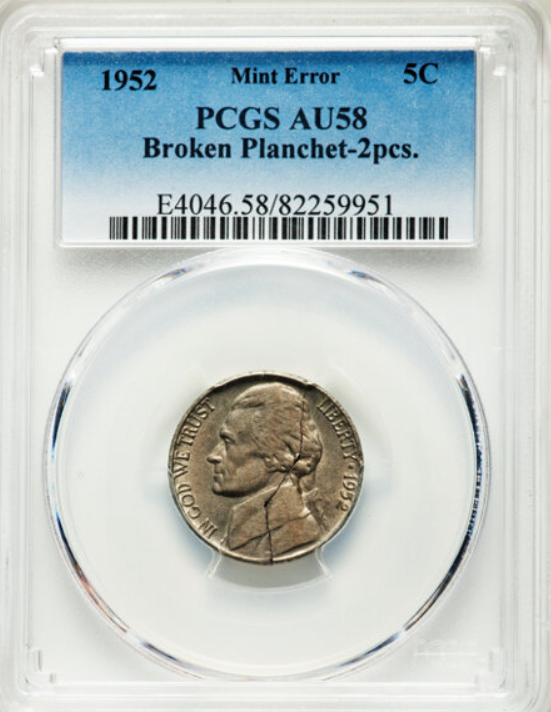
This coin is interesting because the blank was previously damaged. Probably. So when the die hit the planchet, it split in two like a jigsaw. Luckily, the person found both pieces and positioned them together as a pair, which increases their value. It may even have left the mint barely joined and then broken apart later. In AU 58, these twin coins sold for $180.
1952 (P) Nickel Double Struck 90% Off-Center
Every coin is struck at least twice to make sure all the details are clear. Once the coin is complete, the feeder fingers slide it out of the press and into the coin vat. But sometimes there’s a lag and the coin is struck again as it exits. This causes overlapping images and can sometimes spoil the shape of the coin. Here, the 90% misalignment in MS 62 sold for $190.
1952-S Nickel Struck 50% Off-Center
Double strikes and misalignment errors both happen if the coin isn’t directly between the dies. But if the blank moves before the die hits it for the first time, part of its surface will stay unmarked. These off-center errors are marked by the percentage of misalignment, and this one is roughly half empty. Graded MS 64 FS, it sold for more than $440 due to its condition.
1952 (P) Nickel Struck on a Dime Planchet
Every coin has a weight and thickness defined by law, and sometimes, a coin is struck on a blank that was intended for another denomination. Here, the 5c coin was struck on a 10c planchet. Since dimes are smaller (17.91mm instead of 21.21 mm), it ended up weighing 2.4g instead of 5g, and some design details got sliced off. Even in AU 55 grade, it sold for $470.
1952 (P) Nickel Struck on a Penny Planchet
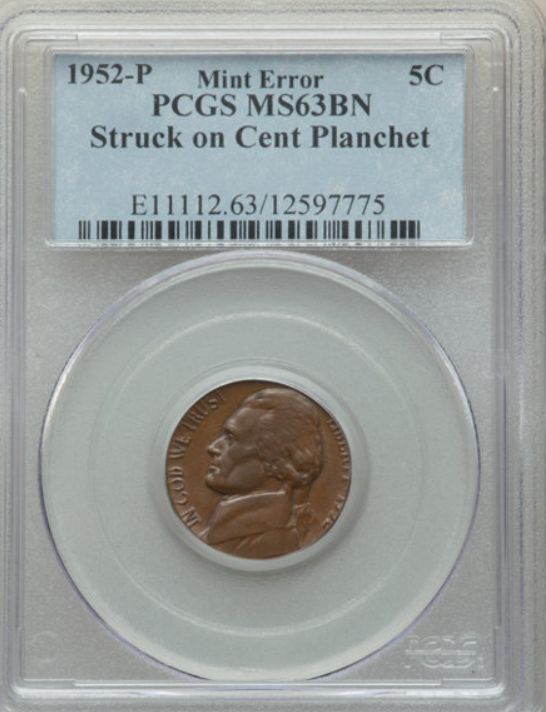
Here’s a similar error, but this time, the nickel was struck on a 95% copper planchet meant for a 1c coin. Since pennies have that reddish copper color, the mint mistake is instantly recognizable. And pennies are 19.05mm across, compared to nickels which are 21.21mm, so once again, some of the design details are truncated. Graded MS 63 BN, it sold for $600.
1952 Nickels Split After Strike – Two Pieces
If you have low-quality coins with unusual errors, you can raise their value by selling them as a batch. That’s what happened with these pieces. They’re two individual pieces of a coin that split edgewise after striking, so you can see clear designs on one side and jagged surfaces on the other. The horizontally slashed pieces were graded a low XF 40 but still sold for $322.
1952 (P) Nickel Clamshell Lamination Error
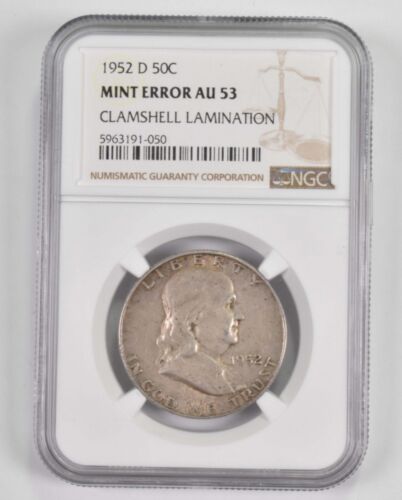
Planchets that have mixed metals are often cast in layers. And sometimes, when the dies strike the blank, some of the layers peel or scrape off. It could be the whole obverse or reverse. Or it could be a tiny crack that exposes a different metal underneath. This is called a lamination error, and the type on this coin is a clamshell. In F 15, a super-low grade, it’s $35.
Also read: 14 Most Valuable Nickel Errors Worth Money
Where to Sell Your 1952 Nickel ?
Now that you know the value of your coins, do you know where to sell those coins online easily? Don’t worry, I’ve compiled a list of these sites, including their introduction, pros, and cons.
Check out now: Best Places To Sell Coins Online (Pros & Cons)
1952 Nickel FAQ
Is a 1952 Nickel All Silver?
No, the 1952 Nickel is 75% Copper and 25% Nickel. The only modern nickels that have any silver in them are Wartime Nickels coined from 1942 to 1945. Those ones are 35% Silver.

